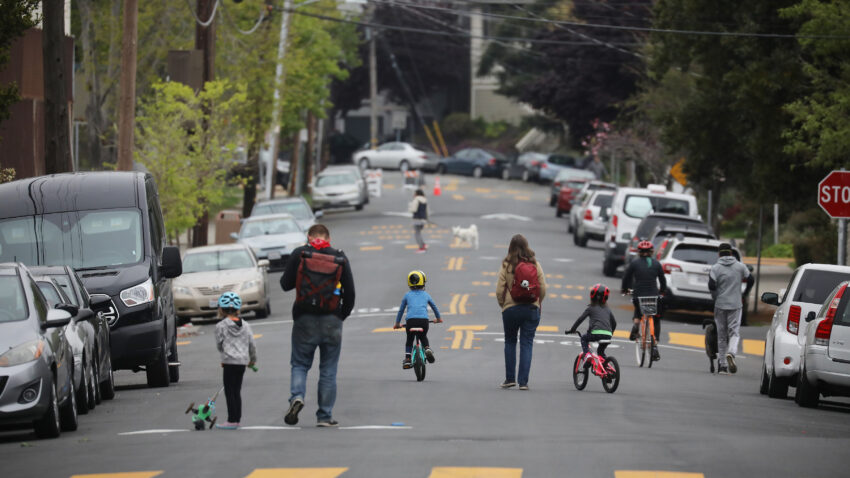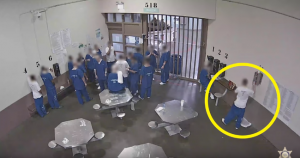With vehicle traffic dramatically reduced in Boston, officials are looking to make better use of the city’s streets during the coronavirus outbreak.
During a Boston City Council hearing Tuesday night, Boston’s top transportation planner said the city is preparing to expand sidewalks into driving lanes in certain places “later this month” in order to make more space for pedestrians and cyclists.
“It’s something that the mayor has asked us to start implementing as soon as possible,” Vineet Gupta, the director of planning for the city transportation department, said during the teleconference hearing.
In the midst of the pandemic, a long list of cities have repurposed driving lanes to make social distancing easier for pedestrians — from major metropolises like Paris and London to American cities like San Francisco and Kansas City to just over the border in Brookline.
Proponents say the changes address concerns about both increased speeding due to the emptier streets and pedestrian crowding on the city’s narrow sidewalks, where it can be difficult to stay six feet away other people. State officials have already closed sections of three parkways in Boston and Watertown to car traffic to reduce the concentration of people walking on sidewalks and paths.
Jeff Speck, an author and urban planner, said Tuesday that the coronavirus outbreak was “at its heart, a spatial crisis.”
“The way space has been allocated in our communities is increasing the spread of the disease,” Speck said during a presentation during the hearing.
In Boston, Gupta said the changes will be phased in over the next few months, depending on how the COVID-19 crisis unfolds. However, they’re still finalizing plans and assessing what resources and personnel are available.
Boston Mayor Marty Walsh voiced supported for expanding sidewalks and bike lanes in certain business districts during a press conference Monday, as state officials plan to announce a phased reopening of the economy next week. Neighboring states in New England have already begun announcing plans to let businesses open with capacity limits and other restrictions, such as only allowing outdoor dining and curbside pickup, which could result in more people out on sidewalks.
“We want to make sure our small businesses can get the support they need, and we want to make sure everyone has safe and healthy transportation options,” Walsh said Monday, according to MassLive.
The changes also take a variety of forms, from closing off streets completely to expanding sidewalks into parking lanes, which would be marked off with jersey barriers or orange traffic barrels. Jacob Wessel, Boston’s public realm director, said the city is considering the latter approach in places like Centre Street in Jamaica Plain; Washington Street in Codman Square, and Meridian Street in East Boston.
Another approach being considered in more residential areas is to use signage to close streets to through traffic, to provide more room for cyclists, runners, and pedestrians.
☑️Opening up entire lanes for pedestrian and cyclist use which could also calm traffic speeds.
— Mayor Marty Walsh (@marty_walsh) May 11, 2020
Wessel said the city is also looking at potential pop-up bike lanes — using barrels to repurpose driving lanes, with a focus on ensuring essential health care workers who feel uncomfortable taking public transit can get to work safely. Wessel identified Commonwealth Ave from Kenmore Square to the BU Bridge and Malcolm X Boulevard and Columbus Avenue in the South End as potential area for the ad-hoc bike lanes. He also said they city was considering a similar approach to create pop-up bus lanes.
Whatever the approach, Walsh has noted that the changes would have be done in a way so that emergency and delivery vehicles still have access to the affected areas. During the hearing, Speck also noted that it was not the intention — nor the outcome — of such changes to create a “block party” atmosphere that would induce crowding, such as the city’s carless Open Newbury events each summer.
“There will not be fried dough,” said Speck, who called for a “network” of expanded sidewalks and bike lanes with a focus on essential workers.
Still, the proposed changes come amid pre-pandemic efforts to make Boston’s streets friendlier to pedestrian and cyclists. And city councilors were in lockstep support of the general goals during the hearing Tuesday, which was called by Councilors Michelle Wu and Liz Breadon. Some suggested the temporary changes could help inform future policymaking.
“Sometimes I think we worry, in terms of pouring concrete and making permanent decisions, about whether they’re going to be the right mix for different users, and I think what this terrible situation has given us is a chance to really try some things and see what it opens up and how it enables a different kind of lifestyle,” Councilor Kenzie Bok said.
Councilors Ricardo Arroyo and Annissa Essaibi-George noted that Seattle made some initially temporary changes — closing 20 miles of residential streets to through traffic — permanent. Councilor Lydia Edwards suggested it would be a missed opportunity not to experiment.
“We can’t look at future generations and say we had months of somewhat clear roads — months where we could, without traffic, define and redesign a city — and we didn’t take advantage of that,” Edwards said.



















